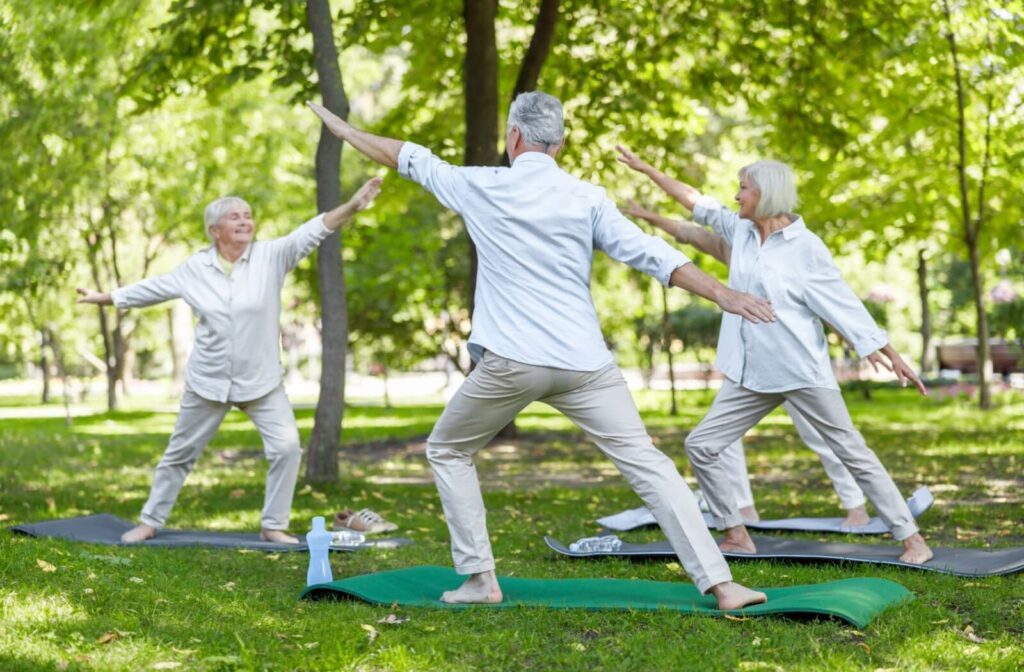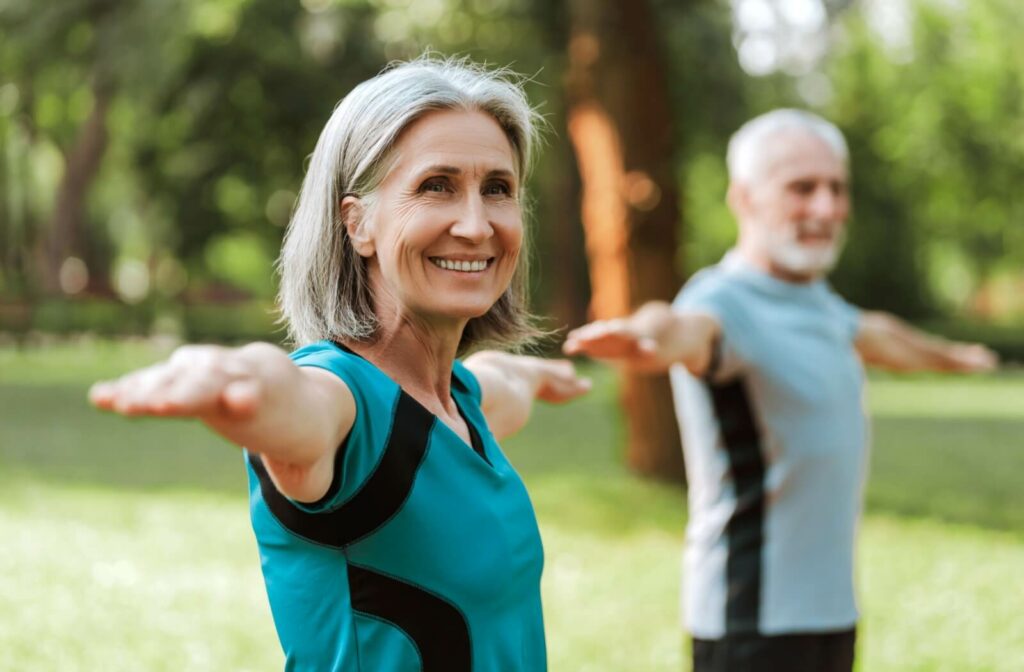Staying physically active is a healthy endeavour for most people, including older adults. Seniors can benefit from exercises that support balance, flexibility, and strength. Feeling physically well can also help older adults enjoy the activities and events they love most.
Simple standing exercises can be helpful to older adults who are interested in maintaining their physical fitness. With movements designed to promote balance, flexibility, and strength, the exercises here are intended to be simple, accessible, and enjoyable for older adults.
Safety Tips
Before you start a new exercise, check in with your healthcare provider. It’s also a good idea to warm up before any physical activity.
Other safety tips to keep in mind:
- Breathe: This may seem obvious, but it’s helpful to focus on your breathing when doing strength training exercises. Exhale as you lift a weight and inhale as you set it down.
- Use sturdy objects: If you need to hold onto something for balance, make sure it’s in good working order and can support you. Avoid exercising on slippery, uneven, or unstable surfaces.
- Start slow: Begin with movements that are easy for you and gradually increase intensity and duration. Avoid sudden movements and stay slow and steady.
- Stay hydrated: Unless you’ve been told by a healthcare provider to reduce fluid intake, proactively hydrating yourself is essential. Sometimes, older adults don’t feel thirsty even when they need water.
- Rest: If you feel tired, it’s okay to take a break. If you experience unpleasant symptoms or are unsure about safety, stop and check in with a healthcare professional.
Exercise for Older Adults with Chronic Conditions
If you have a chronic condition like arthritis, high blood pressure, or cognitive impairment, talk with your doctor. Most people can exercise and benefit from it, including older adults with chronic health conditions. You may just need to tailor exercises to your needs. For example, people with arthritis can benefit from low-impact exercises that put minimal stress on their joints.
Exercise Resources for Older Adults
The following exercises are largely sampled from the National Institute on Aging’s Go4Life campaign. You can find a full list of exercises there with detailed instructions, or check out the YouTube channel for video examples.
Warm-Up
Spend 5 minutes before your routine warming up. A warm-up gets your muscles ready for work. It also helps prevent injury and reduces post-workout soreness. Here are some warm-up ideas:
- Walk around the room or up and down stairs.
- If you don’t have enough room to walk around, try marching in place.
- Explore a simple dynamic stretch like a chin drop or arm opener

Balance Exercises
Balance exercises can help older adults avoid falls and injury. Doing 3 balance exercise sessions a week is a good goal. Here are some balance exercise ideas:
- Single leg balance: Hold on to something sturdy and stand on one foot. Try to stay in this position for 10 seconds. Then, switch legs and repeat.
- Heel-to-toe walk: Stand with your arms outstretched for balance, then put 1 foot in front of the other with the heel of your front foot touching the toes of the back foot.
- Tai Chi: This ancient Chinese martial art is very popular among older adults because it uses slow and gentle movements to promote balance.
Flexibility Exercises
Flexibility can make everyday movements easier. If you have shoulder issues or had hip or back surgery, talk to a doctor before trying these exercises.
- Shoulder and upper arm stretch using a towel: Hold one end of a towel over your shoulder behind you. Then, use your other hand to pull it back, stretching out the top arm’s shoulder. Switch sides and repeat.
- Thigh stretch using a chair: Hold on to the back of a chair for balance with one hand. Bend back the opposite leg until your foot is in your hand, stretching out your thigh. You can also loop a towel around your ankle if you can’t reach your foot.
Tips for Strength Training
Strength training can help older adults remain independent for longer, as it can strengthen muscles for everyday tasks. Aim to do strength training 2 days a week. Avoid working out the same muscle group 2 days in a row.
Here are some ideas for strength training:
- Leg raises: With your hand on a sturdy chair for balance, lift your leg straight back without bending it. Hold this position and lower it back down slowly. A similar exercise is the side leg raise, where you slowly lift, hold, and lower a leg that’s out to the side.
- Wall push-ups: Stand about arm’s length away from a wall and place your palms on it. Then, bend your arms so that your upper body moves toward the wall.
- Toe raises: Using a chair for support, lift yourself onto your toes as high as possible, hold this position for 1 second, and then set yourself back down.
Exercise & Wellness at The Lodge at Historic Lewes
When it comes to physical wellness, age shouldn’t be a barrier. A simple standing exercise routine can be an excellent addition to an older adult’s daily routine. It can help promote strength, balance, and flexibility, reducing or preventing falls and injury. But remember to listen to your body, work out at your own pace, and don’t hesitate to ask for help if something feels wrong.
At The Lodge at Historic Lewes, we believe that quality of life should improve when you move into a senior living community. That’s why we offer many services and amenities along with events and activities to help our residents stay active and engaged. To learn more about what we offer, we invite you to book a tour today.




